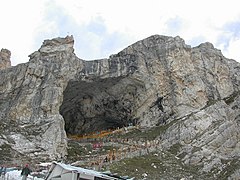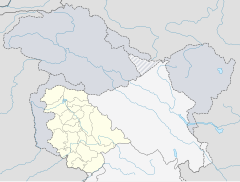Amarnath yatra
| Amarnath Cave | |
|---|---|

Amarnath Cave Temple
|
|
| Name | |
| Proper name | Amarnath Cave Temple |
| Devanagari | अमरनाथ गुहा |
| Sanskrit transliteration | Amarnāth Guhā (IAST) |
| Geography | |
| Coordinates | 34°12′54″N 75°30′03″E / 34.2149°N 75.5008°ECoordinates: 34°12′54″N 75°30′03″E / 34.2149°N 75.5008°E |
| Country | India |
| State | Jammu and Kashmir |
| Location | Pahalgam, Anantnag |
| Culture | |
| Primary deity | Shiva |
| History and governance | |
| Creator | Natural formation |
| Website | www |
Amarnath cave is a Hindu shrine located in Jammu and Kashmir, India. The cave is situated at an altitude of 3,888 m (12,756 ft), about 141 km (88 mi) from Srinagar, the capital of Jammu and Kashmir and reached through Pahalgam town. The shrine forms an important part of Hinduism, and is considered to be one of the holiest shrines in Hinduism. The cave is surrounded by snowy mountains. The cave itself is covered with snow most of the year except for a short period of time in summer when it is open for pilgrims. Thousands of Hindu devotees make an annual pilgrimage to the Amarnath cave on challenging mountainous terrain to see an ice stalagmite formed inside the cave.
Inside the 40 m (130 ft) high Amarnath cave, the stalagmite is formed due to freezing of water drops that fall from the roof of the cave on to the floor and grows up vertically from the cave floor. It is considered to be a Shiva Linga by Hindus. It is mentioned in the ancient Hindu texts of Mahabharata and Puranas that Lingam represents Lord Shiva. The Cave waxes during May to August, as snow melts in the Himalayas above the cave and the resultant water seeps into the rocks that form the cave and gradually wanes thereafter. As per the religious beliefs, it has been claimed that the lingam grows and shrinks with the phases of the moon reaching its height during the summer festival, although there is no scientific evidence for this belief.
According to a Hindu legend, this is the cave where Shiva explained the secret of life and eternity to his divine consort, Parvati.
The book Rajatarangini (Book VII v.183) refers to Amareshwara or Amarnath. It is believed that Queen Suryamathi in the 11th century AD gifted trishuls, banalingas and other sacred emblems to this temple. Rajavalipataka, begun by Prjayabhatta has detailed references to the pilgrimage to Amarnath Cave. Other than this, there are further references to this pilgrimage in many other ancient texts.
It is believed that after the Middle Ages, this cave was forgotten by people before it was discovered by a shepherd in the 15th century once again.
Another story relates to Bhrigu Muni. Long time ago it is believed that The Vale of Kashmir was submerged under water and Kashyapa Muni drained it through a series of rivers and rivulets. Therefore, when the waters drained, Bhrigu Muni was the first to have Darshan of Lord Amarnath. Thereafter, when people heard of the Lingam, it became an abode of Lord Bholenath for all believers and a pilgrimage which is done by lakhs of people each year. As we well know Francois Bernier, a French physician accompanied Emperor Aurangzeb during his visit to Kashmir in 1663. In his book “Travels in Mughal Empire” he writes while giving an account the places he visited in Kashmir that he was “pursuing journey to a grotto full of wonderful congelations, two days journey from Sangsafed” when he “received intelligence that my Nawab felt very impatient and uneasy on account of my long absence”. The “grotto” he refers to is obviously the Amarnath cave as the editor of the second edition of the English translation of the book, Vincient A. Smith makes clear in his introduction. He writes: “The grotto full of wonderful congelations is the Amarnath cave, where blocks of ice, stalagmites formed by dripping water from the roof are worshipped by many Hindus who resort here as images of Shiva…..”
...
Wikipedia


